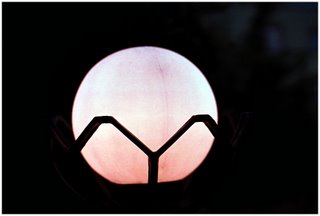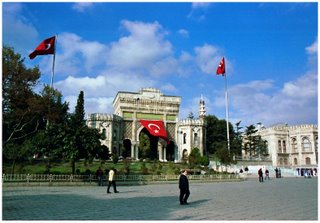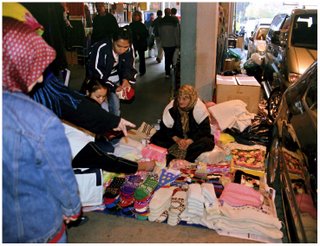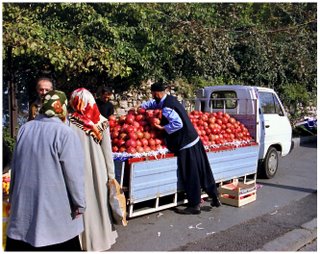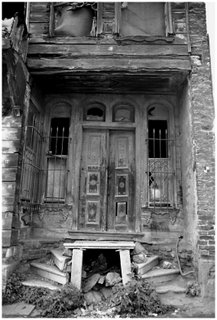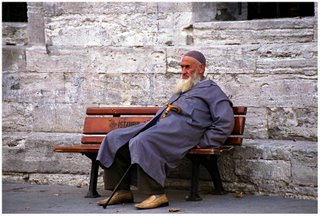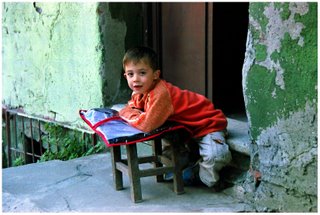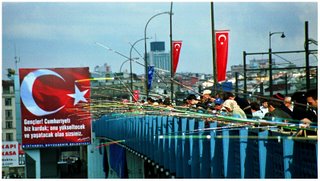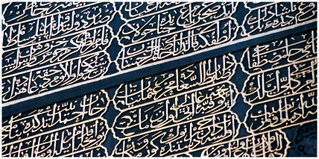Tuesday, November 21, 2006
Saturday, November 18, 2006
Aya Sofia - The Church of The Divine Wisdom
 Situated in the heart of former Constantinople, the last stronghold of the roman empire and the capital of christianity, Aya Sofia was erected between 532 and 537 AD, by the Emperor Justinian.
Situated in the heart of former Constantinople, the last stronghold of the roman empire and the capital of christianity, Aya Sofia was erected between 532 and 537 AD, by the Emperor Justinian.  Overview of the minarets, built after the convertion by Mehmet, The Conqueror.
Overview of the minarets, built after the convertion by Mehmet, The Conqueror.
 The word Allah caligraphed on huge placards, symbols of Islam.
The word Allah caligraphed on huge placards, symbols of Islam.
 When the Ottoman Turks conquered the city in 1453, the Aya Sofia was converted into a mosque.
When the Ottoman Turks conquered the city in 1453, the Aya Sofia was converted into a mosque. Deesis-mosaics from the beginning of the 14th century, representing Christ enthroned with on one side the Virgin Mary, on the other John The Baptist.
Deesis-mosaics from the beginning of the 14th century, representing Christ enthroned with on one side the Virgin Mary, on the other John The Baptist. More examples of the phenomenon called "The Palaeologian Renaissance" led to a renewal of the Byzantine mosaic art.
More examples of the phenomenon called "The Palaeologian Renaissance" led to a renewal of the Byzantine mosaic art.
 This paintings showed a predilection for perspective and three-dimensionalism.
This paintings showed a predilection for perspective and three-dimensionalism. View of the Blue Mosque, another symbol of Istanbul, from the Aya Sofia.
View of the Blue Mosque, another symbol of Istanbul, from the Aya Sofia. Aya Sofia, called Hagia Sofia in greek, by night.
Aya Sofia, called Hagia Sofia in greek, by night. Photography by Nuno Goncalves. Istanbul, Turkey 2006.
Saturday, November 11, 2006
Istanbul by Night
Friday, November 10, 2006
Walk about Istanbul!
 XXI Century... Unbelievable!!!
XXI Century... Unbelievable!!!
Pondering life.
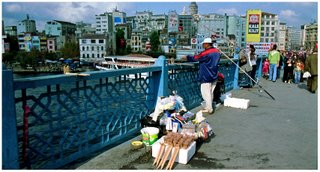 Fisherman's at the Galata Bridge.
Fisherman's at the Galata Bridge.
Guess how many rods?
Photography by Nuno Goncalves. Istanbul, Turkey 2006.Wednesday, November 08, 2006
The most prominent landmarks of Istanbul
 Founded by Sultan Ahmet I, the Blue Mosque was design by Mehmed Aga. The constuction begin in 1609 and was completed in 1616.
Founded by Sultan Ahmet I, the Blue Mosque was design by Mehmed Aga. The constuction begin in 1609 and was completed in 1616.
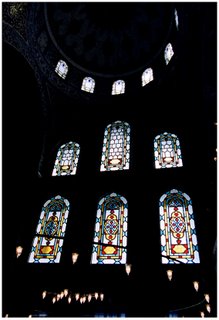 Beautiful windows of the Blue Mosque.
Beautiful windows of the Blue Mosque.
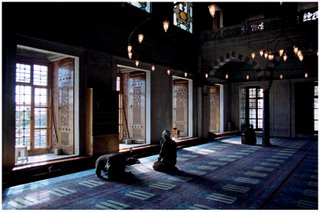 Everybody should turn their face to the south when praying, because Mecca( Saudi Arabia), is located in South.
Everybody should turn their face to the south when praying, because Mecca( Saudi Arabia), is located in South.
 The pulpit and nave are made of marble. The Imam (priest), goes on the pulpit every Friday on the sacred day of the Muslims but he never climbs to the very top as a respect to Prophet Muhammed.
The pulpit and nave are made of marble. The Imam (priest), goes on the pulpit every Friday on the sacred day of the Muslims but he never climbs to the very top as a respect to Prophet Muhammed.
 Praying have place five times a day. First one early in morning, second at noon time, third in afternon, fourth in evening and last one before going to bed.
Praying have place five times a day. First one early in morning, second at noon time, third in afternon, fourth in evening and last one before going to bed.
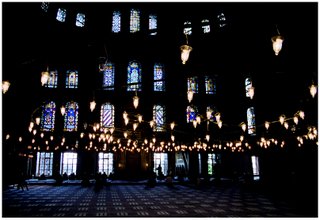 Overview of the chandeliers and windows inside the Blue Mosque.
Overview of the chandeliers and windows inside the Blue Mosque.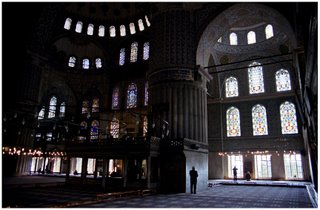 The mosque has 260 windows which let the sunlight diffuse into the building quite nicely. They were filled with stained-glass in early 17C but they were restored later.
The mosque has 260 windows which let the sunlight diffuse into the building quite nicely. They were filled with stained-glass in early 17C but they were restored later.
 It is all carpeted with prayer rugs because people must put their forehead on the floor and therefore the floor should be soft and clean.
It is all carpeted with prayer rugs because people must put their forehead on the floor and therefore the floor should be soft and clean.
 Overview of the inside of the Blue Mosque.
Overview of the inside of the Blue Mosque.
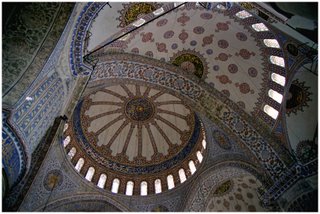 The mosque is all surrounded by beautiful 17C Iznik tiles which give its name to the Blue Mosque.
The mosque is all surrounded by beautiful 17C Iznik tiles which give its name to the Blue Mosque.
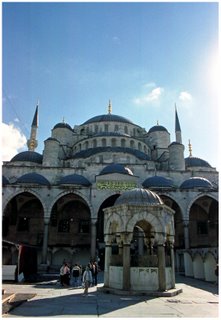 There is a fountain in the middle of the main courtyard, which is used as decorative purposes.
There is a fountain in the middle of the main courtyard, which is used as decorative purposes.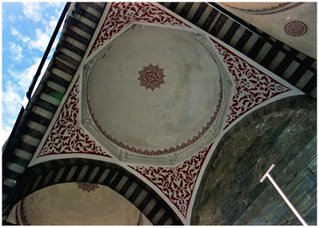 The marble courtyard is priceless. Its marble comes from the Island of Marmara (the turkish word for marble).
The marble courtyard is priceless. Its marble comes from the Island of Marmara (the turkish word for marble).
 Before praying, one should wash his/her face, arms, neck and feet as well as mouth and nose at the ablution fountains, situated at the big courtyard.
Before praying, one should wash his/her face, arms, neck and feet as well as mouth and nose at the ablution fountains, situated at the big courtyard. Detail of the Blue Mosque.
 Overview of the Blue Mosque by sunset.
Overview of the Blue Mosque by sunset.
Photography by Nuno Goncalves. Istanbul, Turkey 2006.













